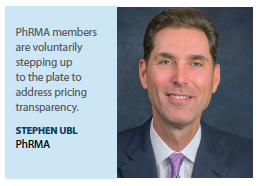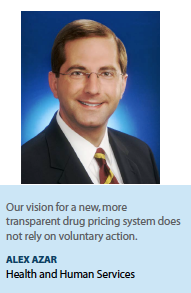In the ongoing clash between pharma and the Trump administration over pricing issues, CMS proposed a rule last year that would require pharmaceutical companies to include the price of any drug that cost more than $35 a month in their television ads. PhRMA preempted the salvo with a voluntary pledge to provide information in DTC ads that would direct patients to information about medicine costs, including the list price of the medicine, out-of-pocket costs, and available financial assistance. The biopharmaceutical industry says it will also launch a new platform that will provide patients, caregivers, and providers with cost and financial assistance information for brand-name medicines, as well as other patient-support resources.
“Our member companies are taking a new approach to how they communicate about medicines in DTC television advertisements to make it easier for patients to access information about medicine costs," says Stephen Ubl, president and CEO of PhRMA. “The Administration and Congress have called on our industry to provide cost information in DTC advertisements, and our members are voluntarily stepping up to the plate."
PhRMA’s argument for not accepting the new proposed rule is that the rule is flawed, and if enacted, the information required will only confuse patients. The industry says it is not opposed to including pricing information to patients, but to squeeze it into a 30-second TV spot, which is already crammed with required safety information, will not be helpful to patients.
“PhRMA remains concerned that just including list prices in these advertisements is not sufficient and could discourage patients from seeking needed medical care," Mr. Ubl says. “List prices are not a good indicator of what a patient will pay at the pharmacy counter and do not reflect the substantial discounts and rebates negotiated by insurers and pharmacy benefit managers."
A better solution according to PhRMA is providing information within the ad that leads patients to a repository of information that has a larger format capable of explaining the very complex drug pricing and payer system.
Health and Human Services Secretary Alex Azar, commenting in a prepared statement, says the industry is not doing enough, and government intervention is necessary to bring down the high prices for patients.
“Patient empowerment and transparency are at the core of President Trump’s drug-pricing blueprint that was released five months ago," Mr. Azar says. “Our vision for a new, more transparent drug pricing system  does not rely on voluntary action. The drug industry remains resistant to providing real transparency around its prices, including the sky-high list prices that many patients pay. So while the pharmaceutical industry’s action is a small step in the right direction, we will go further and continue to implement the President’s blueprint to deliver new transparency and put American patients first."
does not rely on voluntary action. The drug industry remains resistant to providing real transparency around its prices, including the sky-high list prices that many patients pay. So while the pharmaceutical industry’s action is a small step in the right direction, we will go further and continue to implement the President’s blueprint to deliver new transparency and put American patients first."
PhRMA also takes umbrage with the requirement because it says the rule raises significant legal issues, including First Amendment concerns. If the proposed rule is ever passed, the industry will likely sue for violation of its First Amendment rights. Additionally, if approved, the proposed rule will have no government power to enforce the new rule, attorneys note.
“While making drug prices more transparent is a laudable goal, compelling the disclosure of a drug’s list price in TV ads will no more help consumers understand what they will ultimately pay for a medication than had CMS required the use of a randomly generated three-digit number as the advertised price," says Sheldon Bradshaw, partner, King & Spalding. “Instead, disclosure of the list price will serve to mislead and harm patients. And for those who still care about such things, compelling drug companies to engage in government required speech violates the First Amendment."
Mr. Bradshaw speaks from a significant point of reference, as he served as chief counsel of the FDA from 2005 to 2007. In that role, he provided legal advice to the Secretary and Deputy Secretary of the U.S. Department of Health and Human Services, as well as to FDA’s senior leadership, on issues relating to drugs, biologics, medical devices, food, and other regulated products.
The government is allowed to require companies to disclose prices in ads, but the question in this case is whether the requirement is constitutional.
According to Mr. Bradshaw, laws that compel speech — including those that regulate how sellers may  communicate their prices — are subject to heightened judicial scrutiny. Those laws are permissible under the Constitution only if they are narrowly tailored to serve an especially compelling governmental interest. “It should go without saying that the government never has a compelling interest in misleading the public," Mr. Bradshaw says. “For this reason alone there is no compelling government interest in requiring pharma companies to disclose the list price of drugs they advertise."
communicate their prices — are subject to heightened judicial scrutiny. Those laws are permissible under the Constitution only if they are narrowly tailored to serve an especially compelling governmental interest. “It should go without saying that the government never has a compelling interest in misleading the public," Mr. Bradshaw says. “For this reason alone there is no compelling government interest in requiring pharma companies to disclose the list price of drugs they advertise."
If PhRMA or drug companies decide to sue HHS for First Amendment violation, the case will rest on whether the prices the government wants companies to disclose can be identified as relevant to consumers.
Beyond First Amendment concerns and the thought that WAC prices in DTC ads may misconstrue the value of a drug to a patient, some analysts also note that publishing drug prices in ads does nothing to guarantee those prices are going to drop, as suggested. More likely, some companies may choose to avoid using TV for brand messaging, which could create a void in patient education opportunities and actually lessen transparency.
Analysts from Leerink predict that a pharma marketer or business unit executive is more likely to abandon television DTC than lower the list price of a drug to make the price disclosed to consumers more palatable.
Rachel Sachs, an associate professor of law at Washington University in St. Louis, suggests that the drug industry could argue that Congress gave the FDA authority to regulate drug maker direct-to-consumer marketing, and not CMS, but the real point is how will disclosing the prices help bring down drug prices. Leerink’s Geoffrey Porges agrees, reporting in an Oct. 16, 2018 note that the measure would not materially alter the pricing landscape or lead to significant price cuts.
Despite the industry’s reluctance, transparency around drug pricing was bound to come to a head even if CMS did not get involved. Every stakeholder is looking for ways to reduce costs and improve patient  access, so the industry must have seen this one coming. Now pharma companies need to align their commercial strategies in such a way that every stakeholder can get a better understanding of the very complex pricing system, and more specifically to ensure that patients can understand the difference between WAC and their out-of-pocket costs at the pharmacy.
access, so the industry must have seen this one coming. Now pharma companies need to align their commercial strategies in such a way that every stakeholder can get a better understanding of the very complex pricing system, and more specifically to ensure that patients can understand the difference between WAC and their out-of-pocket costs at the pharmacy.
It will be months or longer before we know if the administration’s proposal will become law, but most experts feel the move is unnecessary and possibly unconstitutional.
Regardless of who wins the legal tug of war, the industry will need to change its approach to DTC advertising and address pricing transparency in order to address patient needs and live up to its voluntary movement. (PV)
~~~~~~~~~~~~~~~~~~~~~~~~~
PhRMA Members Support Voluntary DTC Principles
PhRMA member company leaders comment on the organization’s pledge to provide information in DTC ads that will direct patients to information about their medicine costs.
 Brent Saunders
Brent Saunders
Chairman and CEO,
Allergan
Since 2016, Allergan has been focused on enhancing our patient assistance programs and working with policymakers and payers to facilitate access to our medicines. The new PhRMA DTC principles will give patients and consumers easier access to information that will help them understand how much they might pay for their medicines, and we view them as a natural extension of our social contract with patients.
 Ruud Dobber
Ruud Dobber
President, AstraZeneca US, Executive VP, North America
As the first company to include messages about our affordability programs in all of our DTC TV advertisements — if you can’t afford your medication, AstraZeneca may be able to help — we believe this action is a natural extension of our existing access and affordability commitment to patients. And we are pleased to see all PhRMA member companies agree to move in this direction.
 Dave Ricks
Dave Ricks
Chairman and CEO,
Eli Lilly and Company
Lilly is proud to join our peers in this new commitment to improve transparency of the costs of medicines, both the list price of medicine and expected patient out-of-pocket costs. Direct-to-consumer advertising is an important way to create awareness about new medicines and therapeutic breakthroughs. Now our ads will also include helpful information about the expected costs of those medicines. While greater transparency is one step forward, we need to accelerate our work to lower the out-of-pocket costs for medicine at the pharmacy counter. We know many Americans who pay for insurance or are eligible for a federal program still struggle to pay for their medicine. We are committed to working with stakeholders across the healthcare system to find more solutions.
 Joaquin Duato
Joaquin Duato
Vice Chairman of the Executive Committee,
Johnson & Johnson
Transparency is an important step toward a more sustainable, results-based health system that delivers greater access to care at a more manageable cost. This belief inspired us to release our annual Janssen U.S. Transparency Report, beginning in 2017, continuing our legacy of leadership in responsible pricing and transparency. We are proud to stand with PhRMA as we commit to providing patients with meaningful and relevant information about the cost of their medicines. This announcement marks another important milestone as we strive toward a healthcare system that ensures greater access to medicines for patients today and continued breakthroughs for patients tomorrow.
 Vas Narasimhan, M.D.
Vas Narasimhan, M.D.
CEO, Novartis
Novartis supports the DTC advertising principles put forth by PhRMA. This is another step forward to ensuring patients have all the information they need to understand their out-of-pocket costs to make the most appropriate and informed decisions about their prescription medicines.
 Olivier Brandicourt, M.D.
Olivier Brandicourt, M.D.
CEO, Sanofi
Sanofi has been a leader in responsible pricing by implementing one of the industry’s most progressive and comprehensive pricing policies and by providing programs to help patients access their medicines. We are pleased to join these efforts to provide information and resources to help address the affordability challenges many people face in accessing medicines. While there is more work to be done with all those involved in the healthcare system, we believe this is a step in the right direction.
~~~~~~~~~~~~~~~~~~~~~~~~~
Comparing CMS Proposal vs. PhRMA Voluntary Guidance
CMS
On Oct. 15, 2018, CMS released a proposed rule titled “Medicare and Medicaid Programs: Drug Pricing Transparency," which would require direct-to-consumer (DTC) advertisements for prescription drugs covered by Medicare or Medicaid to include the wholesale acquisition cost (WAC). This proposed rule resembles a rejected Senate amendment to the FY-2019 Labor-HHS-Education appropriations bill that would have provided the department of Health and Human Services (HHS) $1 million to implement rules requiring manufacturers to disclose drug list prices in DTC advertising; however, House Republicans declined to adopt that amendment.
Specifically, the proposed rule would require DTC ads to include a text statement disclosing the WAC for a typical 30-day regimen or for a typical course of treatment, whichever is most appropriate. No voiceover would be required. The proposed rule includes an exception for drugs with a WAC of less than $35 per month.
It is notable that the proposed blueprint charged the FDA with evaluating whether and how to require manufacturers to include list prices in advertising; yet, the proposed rule was released by CMS and not FDA, and is based on CMS’ authority to regulate the Medicare and Medicaid programs.
This proposed enforcement mechanism relies primarily on a private right of action under existing competition laws and, secondarily, public admonition by CMS. Under the proposed rule, HHS would maintain a public list of drugs advertised in violation of the rule, but the rule anticipates that the primary enforcement mechanism would be the potential of private suits under the Lanham Act for unfair competition in the form of false or misleading advertising.
PhRMA
On Oct. 2, 2018, PhRMA’s board of directors adopted enhancements to PhRMA’s voluntary DTC principles, Guiding Principles on Direct-to-Consumer Advertisements About Prescription Medicines (originally adopted in 2006). The DTC principles have been expanded to include a new guiding principle stating: “All DTC television advertising that identifies a medicine by name should include direction as to where patients can find information about the cost of the medicine, such as a company-developed website, including the list price and average, estimated, or typical patient out-of-pocket costs, or other context about the potential cost of the medicine."
All current PhRMA members have voluntarily and independently committed to being signatories to the updated DTC principles. The revised principles become effective on April 15, 2019, but changes to PhRMA members’ DTC television advertisements will begin sooner. Signatory companies’ CEOs and chief compliance officers will certify on an annual basis that they have policies and procedures in place to foster compliance with the updated principles.
PhRMA is partnering with consumer, patient, pharmacist, provider, and consumer groups, including CancerCare, the National Alliance on Mental Illness, the National Consumers League, the National Community Pharmacists Association, and the National Medical Association to develop a new patient affordability platform that will launch in early 2019. The new platform will include resources, such as:
An enhanced search tool that includes medicine-specific public cost and affordability information, including the new information companies will direct patients to via their DTC TV advertisements;
Information on how to access company-specific patient assistance and other forms of cost-sharing support, which isn’t currently available on the PPA site;
Resources to help patients navigate their insurance coverage.
PhRMA members are also taking a more proactive approach to offer pro-consumer solutions such as ensuring patients benefit from negotiated rebates at the pharmacy, improving predictability and affordability in Medicare Part D, supporting a limit on opioid prescriptions for acute pain to seven days, eliminating barriers to value-based contracts, facilitating generic competition, and modifying PhRMA’s membership criteria to establish a minimum investment in R&D to be eligible for membership.


















